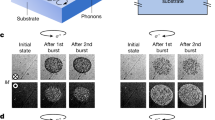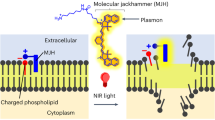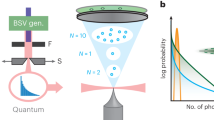Abstract
Infrared (IR) excitation of vibrations that participate in the reaction coordinate of an otherwise thermally driven chemical reaction are believed to lead to its acceleration. Attempts at the practical realization of this concept have been hampered so far by competing processes leading to sample heating. Here we demonstrate, using femtosecond IR-pump IR-probe experiments, the acceleration of urethane and polyurethane formation due to vibrational excitation of the reactants for 1:1 mixtures of phenylisocyanate and cyclohexanol, and toluene-2,4-diisocyanate and 2,2,2-trichloroethane-1,1-diol, respectively. We measured reaction rate changes upon selective vibrational excitation with negligible heating of the sample and observed an increase of the reaction rate up to 24%. The observation is rationalized using reactant and transition-state structures obtained from quantum chemical calculations. We subsequently used IR-driven reaction acceleration to write a polyurethane square on sample windows using a femtosecond IR pulse.
This is a preview of subscription content, access via your institution
Access options
Access Nature and 54 other Nature Portfolio journals
Get Nature+, our best-value online-access subscription
$29.99 / 30 days
cancel any time
Subscribe to this journal
Receive 12 print issues and online access
$259.00 per year
only $21.58 per issue
Buy this article
- Purchase on Springer Link
- Instant access to full article PDF
Prices may be subject to local taxes which are calculated during checkout





Similar content being viewed by others
References
Lin, J. et al. Laser-induced porous graphene films from commercial polymers. Nat. Commun. 5, 5714 (2014).
Decker, C. & Elzaouk, B. Laser-induced crosslinking polymerization of acrylic photoresists. J. Appl. Polym. Sci. 65, 833–844 (1997).
Malinauskas, M., Farsari, M., Piskarskas, A. & Juodkazis, S. Ultrafast laser nanostructuring of photopolymers: a decade of advances. Phys. Rep. 533, 1–31 (2013).
Serbin, J. et al. Femtosecond laser-induced two-photon polymerization of inorganic–organic hybrid materials for applications in photonics. Opt. Lett. 28, 301–303 (2003).
Li, L., Gattass, R. R., Gershgoren, E., Hwang, H. & Fourkas, J. T. Achieving λ/20 resolution by one-color initiation and deactivation of polymerization. Science 324, 910–913 (2009).
Gerasimov, T. G. & Snavely, D. L. Vibrational photopolymerization of methyl methacrylate and quantitative analysis of polymerization results. Macromolecules 35, 5796–5800 (2002).
Gu, H. & Snavely, D. L. Vibrational overtone initiated photopolymerization of acrylonitrile. J. Appl. Polym. Sci. 90, 565–571 (2003).
Crim, F. F. Selective excitation studies of unimolecular reaction dynamics. Ann. Rev. Phys. Chem. 35, 657–691 (1984).
Fleming, R. R. & Rizzo, T. R. Infrared spectrum of t-butyl hydroperoxide excited to the 4νOH vibrational overtone level. J. Chem. Phys. 95, 1461–1465 (1991).
Nesbitt, D. J. & Field, R. W. Vibrational energy flow in highly excited molecules: role of intramolecular vibrational redistribution. J. Chem. Phys. 100, 12735–12756 (1996).
Miller, Y., Chaban, G. M., Finlayson-Pitts, B. J. & Gerber, R. B. Photochemical processes induced by vibrational overtone excitations: dynamics simulations for cis-HONO, trans-HONO, HNO3, and HNO3−H2O. J. Phys. Chem. A 110, 5342–5354 (2006).
Koga, N. A review of the mutual dependence of Arrhenius parameters evaluated by the thermoanalytical study of solid-state reactions the kinetic compensation effect. Thermochim. Acta 244, 1–20 (1994).
Smith, I. W. M. The temperature-dependence of elementary reaction rates: beyond Arrhenius. Chem. Soc. Rev. 37, 812–826 (2008).
Atkins, P. W. Physical Chemistry Vol. 5 (Oxford Univ. Press, 1994).
Dunning, G. T. et al. Vibrational relaxation and microsolvation of DF after F-atom reactions in polar solvents. Science 347, 530–533 (2015).
González, L. & Kühn, O. in Handbook of Hydrogen Transfer Vol. 1 (eds Hynes, J. T., Klinman, J. P., Limbach, H.-H. & Schowen, R. L.) 79 (Wiley-VCH, 2006).
Shapiro, M. & Brumer, P. Quantum Control of Molecular Processes 2nd edn (Wiley-VCH, 2011).
Kühn, O. & Wöste, L. (eds) Analysis and Control of Ultafast Photoinduced Reactions, Series in Chemical Physics Vol. 87 (Springer, 2007).
Ventalon, C. et al. Coherent vibrational climbing in carboxyhemoglobin. Proc. Natl Acad. Sci. USA 101, 13216–13220 (2004).
Strasfeld, D. B., Shim, S.-H. & Zanni, M. T. Controlling vibrational excitation with shaped mid-IR pulses. Phys. Rev. Lett. 99, 038102–038106 (2007).
Delor, M. et al. Toward control of electron transfer in donor–acceptor molecules by bond-specific infrared excitation. Science 346, 1492–1495 (2014).
Lin, Z. et al. Modulating unimolecular charge transfer by exciting bridge vibrations. J. Am. Chem. Soc. 131, 18060–18062 (2009).
Witte, T. et al. Controlling molecular ground-state dissociation by optimal vibrational ladder climbing. J. Chem. Phys. 118, 2021–2024 (2003).
Dian, B. C., Longarte, A. & Zwier, T. S. Conformational dynamics in a dipeptide after single-mode vibrational excitation. Science 296, 2369–2373 (2002).
Schanz, R., Boţan, V. & Hamm, P. A femtosecond study of the infrared-driven cis–trans isomerization of nitrous acid (HONO). J. Chem. Phys. 122, 044509 (2005).
Heyne, K., Nibbering, E. T. J., Elsaesser, T., Petković, M. & Kühn, O. Cascaded energy redistribution upon O−H stretching excitation in an intramolecular hydrogen bond. J. Phys. Chem. A 108, 6083–6086 (2004).
Rubtsov, I. V. Relaxation-assisted two-dimensional infrared (RA 2DIR) method: accessing distances over 10 Å and measuring bond connectivity patterns. Acc. Chem. Res. 42, 1385–1394 (2009).
Kasyanenko, V. M., Tesar, S. L., Rubtsov, G. I., Burin, A. L. & Rubtsov, I. V. Structure dependent energy transport: relaxation-assisted 2DIR measurements and theoretical studies. J. Phys. Chem. B 115, 11063–11073 (2011).
Kasyanenko, V. M., Keiffer, P. & Rubtsov, I. V. Intramolecular vibrational coupling contribution to temperature dependence of vibrational mode frequencies. J. Chem. Phys. 136, 144503 (2012).
Heyne, K. et al. Coherent low-frequency motions of hydrogen bonded acetic acid dimers in the liquid phase. J. Chem. Phys. 121, 902–913 (2004).
Owrutsky, J. C., Raftery, D. & Hochstrasser, R. M. Vibrational relaxation dyanmics in solutions. Annu. Rev. Phys. Chem. 45, 519–555 (1994).
Windhorn, L. et al. Getting ahead of IVR: a demonstration of mid-infrared molecular dissociation on sub-statistical timescale. J. Chem. Phys. 119, 641–645 (2003).
Botan, V., Schanz, R. & Hamm, P. The infrared-driven cis–trans isomerization of HONO. II: Vibrational relaxation and slow isomerization channel. J. Chem. Phys. 124, 234511–234519 (2006).
Kössl, F., Lisaj, M., Kozich, V., Heyne, K. & Kühn, O. Monitoring the alcoholysis of isocyanates with infrared spectroscopy. Chem. Phys. Lett. 621, 411–445 (2015).
Heyne, K., Huse, N., Nibbering, E. T. J. & Elsaesser, T. Ultrafast relaxation and anharmonic coupling of O–H stretching and bending excitations in cyclic acetic acid dimers. Chem. Phys. Lett. 382, 19–25 (2003).
Kozich, V., Moguilevski, A. & Heyne, K. High energy femtosecond OPA pumped by 1030nm Yb:KGW laser. Opt. Commun. 285, 4515–4518 (2012).
Kaindl, R. A. et al. Generation, shaping, and characterization of intense femtosecond pulses tunable from 3 to 20 µm. J. Opt. Soc. Am. B 17, 2086–2094 (2000).
Dapprich, S., Komáromi, I., Byun, K. S., Morokuma, K. & Frisch, M. J. A new ONIOM implementation in Gaussian98. Part I. The calculation of energies, gradients, vibrational frequencies and electric field derivatives. J. Mol. Struct. (Theochem) 461–462, 1–21 (1999).
Acknowledgements
The work was supported by the Deutsche Forschungsgemeinschaft (grants nos Ku952/6 and He5206/3, CRC 1078 ‘Protonation Dynamics in Protein Function’, Project B07, CRC 1114 ‘Scaling Cascades in Complex Systems’, Project B05). The authors thank N.P. Ernsting for discussions and the group of S. Reich for Raman microscopy experiments.
Author information
Authors and Affiliations
Contributions
T.S. performed the femtosecond experiments on CH-ol and PHI, analysed the data and contributed to writing the paper. Y.Y. performed the femtosecond experiments on CH-ol and PHI. V.K. performed acceleration measurements, photolithography measurements, analysed the data and contributed to writing the paper. F.K. provided the samples. A.A.A. performed the quantum chemical calculations, analysed their results and contributed to writing the paper. K.H. and O.K. contributed to all measurements, calculations and analysis and wrote the paper. All authors commented on the manuscript.
Corresponding author
Ethics declarations
Competing interests
V.K., F.K. and K.H. are listed as inventors on a patent application describing infrared-light-induced yield optimization of chemical reactions. These patents are pending in the EU (EP2014056220) and the USA (US 2016/0051963). K.H. is also listed on a patent describing a method for polymerizing monomer units and/or oligomer units by means of infrared light pulses. This patent includes US patent no. 1412448 and EU patent no. EP 2718005. The other authors declare no competing financial interests.
Supplementary information
Supplementary information
Supplementary information (PDF 3920 kb)
Rights and permissions
About this article
Cite this article
Stensitzki, T., Yang, Y., Kozich, V. et al. Acceleration of a ground-state reaction by selective femtosecond-infrared-laser-pulse excitation. Nature Chem 10, 126–131 (2018). https://doi.org/10.1038/nchem.2909
Received:
Accepted:
Published:
Issue Date:
DOI: https://doi.org/10.1038/nchem.2909
This article is cited by
-
Energy-efficient pathway for selectively exciting solute molecules to high vibrational states via solvent vibration-polariton pumping
Nature Communications (2022)
-
Ultrafast proton-coupled isomerization in the phototransformation of phytochrome
Nature Chemistry (2022)
-
Effects of laser processing parameters on properties of laser-induced graphene by irradiating CO2 laser on polyimide
Science China Technological Sciences (2022)
-
The quantized chemical reaction resonantly driven by multiple MIR-photons: From nature to the artificial
Nano Research (2021)
-
Solvent tuning of photochemistry upon excited-state symmetry breaking
Nature Communications (2020)



